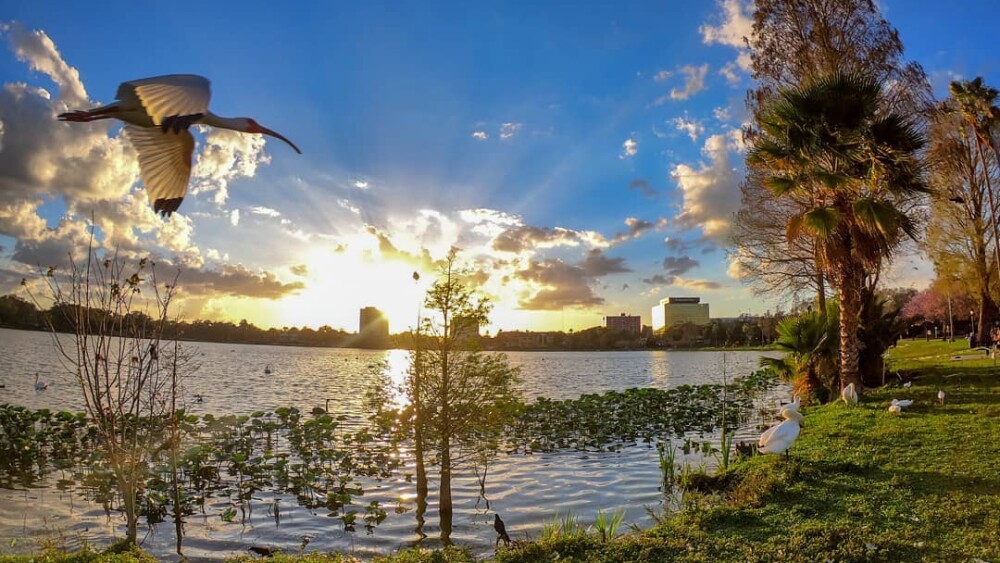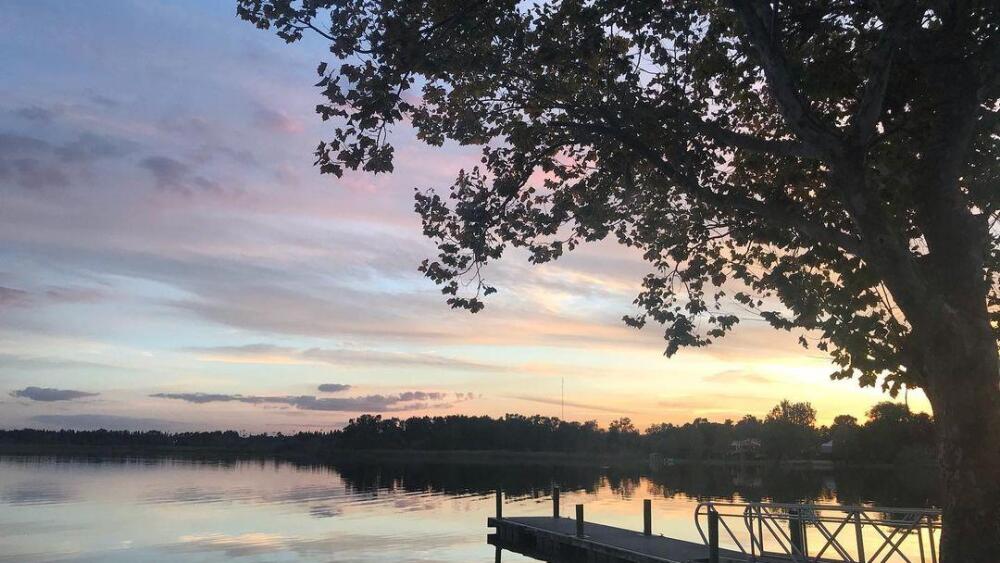This is, arguably, the most important guide a Lakeland resident can read. After all, what would Lakeland be without the lakes? It would be a much shallower place, that’s for sure.
We have pulled together this definitive guide to Lakeland’s lakes. Did you know there are 38 of them? For each section, we’re taking a deep dive into a specific lake.
Lake Hollingsworth
Would it be a Lakeland lakes guide if we didn’t start off with old faithful? Lake Hollingsworth is a 354-acre body of water in central Lakeland. It has an average depth of 4 feet, but its deepest point is 14 feet below the surface. It holds roughly 793 million gallons of water.
Some notable features of the lake include the Lakeland Country Club (929 Lake Hollingsworth Dr.), which sits beside the lake’s large public parking lot; a 3-mile walking and biking trail circumventing the water that is both stroller and wheelchair accessible; and views of Florida Southern College, First Presbyterian Church, and wildlife. There are no public restrooms, so plan accordingly.
Looking to get on the water? The lake has one boat ramp and a separate area within the parking lot for trucks and boat trailers. It is a popular fishing location, with fishing maps available online. It is often home to water skiers, paddle boarders, and leisurely boaters.
Those not ready to dip their toes all the way in can also try hammocking around the lake between trees, rollerblading along the path, or stepping off the path and pausing at the boardwalk.
Now that you have all the info, water you waiting for? Make it out to Lake Hollingsworth and tag us in your photos for a chance to be featured.

Lake Morton wildlife at sunset | Photo via @thehikerdad
Photo via @thehikerdad
Lake Morton
This lake is notable because it’s the swan capital of our city (and as far as we’re concerned, the world).
With a surface area of 39 acres, this lake is both at the heart of downtown Lakeland and Swan City culture. With an average depth of 12 feet and a maximum depth of 22 feet, it holds roughly 152 million gallons of water, giving it slightly less than one-fifth of the volume of Lake Hollingsworth.
We can’t talk about Lake Morton without talking about its famous swans, which have called Lakeland home for nearly 100 years. In the 1950s, Lakeland’s swan population was dwindling. True Lakeland experts will know who enters the story next: The Queen of England. Yes, Queen Elizabeth sent the City of Lakeland a pair of her royal swans. Just like that, Lakeland’s swan population swapped fame for royalty, and the rest is history.
Today, Lake Morton is known for being home to lots of avian wildlife and a staple in the Lakeland community. Sitting at the center of the East and South Lake Morton historic districts, the lake is home to everything from annual events like the Swan Roundup to year-round picnicking, strolling, and birdwatching.
Lake Morton does not have public boating access — this body of water is for birds only. One of its most notable features is the collection of swan cages, where local veterinarians conduct their annual physical checkup on Lakeland’s royal cygnets + swans.
Are you ready for a Lake Morton sunset yet? Make sure you tag us in your swan-derful snaps for a chance to be featured.
Lake Mirror
Special thanks to our friends at the City of Lakeland Lakes and Stormwater division for consulting on this piece.
Today we’re reflecting on one of Lakeland’s most frequented tourist attractions: Lake Mirror.
Just four blocks north of Lake Morton lies Lake Mirror, an 18-acre body of water with an average depth of 8.9 feet and a maximum depth of 17.1 feet. With a volume of 52 million gallons, this lake could fit into Lake Hollingsworth roughly 15 times.
Lake Mirror is known for its walking path, which was completed in 1928 and renamed the Frances Langford Promenade in 1946 in honor of a Lakeland-raised singer and actress. Just under 40 years later, the promenade was added to the US Historic Registry.
Now, the Frances Langford Promenade is home to annually occurring events, such as Red White and Kaboom, the Lakeland Hispanic Festival, the Christmas Parade, SPCA’s Walk for the Animals, and classic car shows.
In addition to the promenade, Lake Mirror is also well known for:
- The old Coca-Cola bottling plant. This historic red-brick building now houses the administrative headquarters for the Lakeland Fire Department. Did you know that there are rumored to be underground tunnels spreading out from beneath the old plant?
- Blinky the Alligator. This beloved communal pet alligator left a mark on Lakeland, especially on those who had the chance to feed him marshmallows and popcorn.
- Hollis Garden. This 1.2-acre neoclassical botanical garden is open to the public for casual viewing or can be rented out for weddings and other private events.
While boating is prohibited on Lake Mirror, visitors are encouraged to walk, picnic, and birdwatch (keep an eye out for wandering swans as well as wood ducks, ibis, egrets, and herons) along the water.

Sunset kayaking on Lake Hunter | Photo via @discoverlkld
Photo via @discoverlkld
Lake Hunter
Roughly eight blocks west of Lake Morton lie 84 acres of water known as Lake Hunter.
With an average depth of 5.6 feet, a maximum depth of 8.9 feet, and a volume of 179 million gallons, Lake Hunter could fit into Lake Hollingsworth nearly 4.5 times. That being said, this natural lake has the largest watershed of any body of water within Lakeland city limits, encompassing roughly 620 acres.
In the south end of RP Funding Center’s parking lot, a 7.5-acre stormwater treatment pond reduces phosphorus, nitrogen, and sediment from stormwater that feeds into the lake, which improves water quality by decreasing the contributing factors to algae blooms.
Back before 1958, when Harden Boulevard and Lake Hunter Drive began providing passage to residents of Dixieland and Lake Hunter Terrace Districts, citrus agriculture and vast wetlands encircled the lake. These days, sidewalks provide space for walkers, bikers and roller skaters to make their way around.
Want a closer look? A public access boat ramp on the lake’s north end gives residents access to kayaking, boating, fishing, and birdwatching. In terms of birds, you can don your binoculars and keep an eye out for herons, egrets, osprey, limpkins, purple gallinules, wood storks, and even the occasional bald eagle.

Lake Wire at sunset | Photo via @rebeccabaumknowles
Photo via @rebeccabaumknowles
Lake Wire
Which lake was originally named “Israel’s Dish?” If you guessed Lake Wire, you’re correct. According to local lore, this lake got its original moniker when a cowboy by that name who was known for camping there left behind a dish that he used as a drinking cup when he moved on.
So, where does “Lake Wire” come from? Following the technology boom of the Industrial Revolution, The International Ocean Telegraph Company constructed the first telegraph wire through Polk County in 1867. The wire skirted around the shoreline of Israel’s Dish, and that’s reportedly how Lake Wire got its name.
The Lake Wire we all know + love is located in the triangle of George Jenkins Boulevard, Sikes Boulevard, and Florida Avenue. The 22-acre naturally formed body of water has an average depth of 10.8 feet and a maximum depth of 22 feet. With a volume of approximately 80 million gallons, it could fit into Lake Hollingsworth nearly 10 times.
Lake Wire is known for having very good water quality. The clarity is in part due to Hydrilla, an invasive species brought here from southeast Asia. Although Hydrilla improves water quality, it does need to be controlled so that it does not outcompete native species. The city routinely harvests excess Hydrilla, but also introduced 80 grass carp into the lake to feed on the plant and control its growth naturally.
Looking to head to Lake Wire? There’s no public access boating ramp, but residents are invited to fish from the shoreline or visit the Lake Wire Palm Collection, which showcases multiple species of palm trees.
Lake Parker
When temperatures start to climb to beach-friendly numbers, it’s time to head to Polk County’s sixth-largest lake, Lake Parker.
At 2,108 acres, Lake Parker is Lakeland’s largest lake. So much so that Lake Hollingsworth could fit in it nearly six times. With an average depth of 5 feet and a maximum depth of 25 feet, this lake holds roughly 5.4 billion gallons of water.

Lake Parker Park is giving the reflections at Lake Mirror a run for their money | Photo via @lizleon
Photo via @lizleon
Boaters can access Lake Parker at three different public-use boat ramps:
- Lake Parker Park (off of North Granada Street from 6:30 a.m.-dusk)
- Lakeland Sertoma Park (off of East Memorial Boulevard, 24 hours per day)
- Lake Parker East Side Park (off of Tanglewood Street and East Lake Parker Drive, 5 a.m.-10 p.m.)
In addition to boating, individuals interested in casting their line can access Lake Parker’s fishing maps online.
Not interested in getting on the water? Head to Lake Parker Park for jogging paths, volleyball, pickleball, and tennis courts, soccer fields, shuffleboard and lawn bowling. Children can play on the Rotary Playground (910 Granada St.), and picnic pavilions both available to the public and for rent.
Did we miss your favorite recreational activity at Lake Parker? Tell us what you enjoy so we can share it with your fellow readers, here.

Lake Bonny under a cotton candy sky. | Photo via @_annarie
Photo via @_annarie
Lake Bonny
After basking in the glory of Swan City’s largest lake, we’re drifting over to Lake Boney.
Yes, you read that right. While it’s now known as Lake Bonny, the 249-acre lake we all know and love was originally registered as Lake Boney, named after David J.W. Boney in 1854. Boney settled in Lakeland in May 1845 and is remembered as a pioneer of the Kissimmee River Valley.
This naturally formed lake could fit in Lake Hollingsworth nearly 1.5 times, making it one of the larger bodies of water on our list. It has an average depth of just 3 feet and can hold roughly 390 million gallons of water.
Ready to hit the water? Find a public boat ramp on the lake’s northeast side (located on Main Street) for Lakelanders looking to boat, fish, or kayak. If you’re more comfortable on solid ground, head to Fletcher Park (800 US 98 S.) and walk along the boardwalk overlooking the lake. From there, check out the playground (renovated in 2016), skatepark, and hiking trail.
There are plenty of other opportunities to hit the lake, hang a hammock on the shores, or take up skateboarding at Fletcher Park. Don’t forget to tag us in your lakefront snaps for a chance to be featured.
Quiz
You might be done with school, but it’s time we put our study guide to use. Now that you’ve read through our full lakes guide, put yourself to the test by taking our quiz about Lakeland’s lakes.












